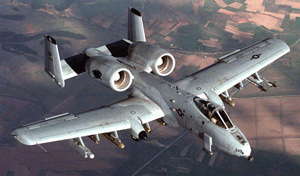Technological advancements don’t always involve brand-new applications; sometimes, progress can be made when older technology is utilized in new ways. Such is the case with aircraft used for scientific research. “Experienced” military aircraft have proven to be effective for many types of atmospheric studies, and with the news (subscription required) that a powerful combat plane used by the military for many years is to be reconfigured and given a new assignment, many are looking forward to even greater research capabilities. Originally developed in the 1970s, the Fairchild Republic A-10 Thunderbolt II, better known as the “Warthog” or just “Hog,” is a twin-engine jet designed for close air support of ground forces. Now it’s being prepared to take on powerful storms.
For many years, the military plane of choice for research inside thunderstorms was the T-28. But as early as 1985, scientists recognized that this aircraft lacked the altitude reach, endurance, and payload capacity to adequately address many of their questions. After a number of workshops to study other options, the A-10 Thunderbolt was identified as a prime candidate to become the Next Generation Storm-Penetrating Aircraft. A subsequent engineering evaluation confirmed the scientists’ view of the A-10 Thunderbolt, but the U.S. Air Force was resistant to authorizing the jet for civilian use. With the advent of the Center for Interdisciplinary Remotely Piloted Aircraft Studies (CIRPAS), a research center at the Naval Postgraduate School in Monterey, California, an opportunity opened to put an A-10 Thunderbolt into service of the civilian science community. In 2010, the U.S. Air Force agreed to transfer an A-10 Thunderbolt out of mothballs to the U.S. Navy and, with funding from the National Science Foundation (NSF), and let CIRPAS (on behalf of the Naval Postgraduate School) operate it as it has operated a Twin Otter and other aircraft for the last 15 years. CIRPAS aircraft are equipped with basic meteorological, cloud, and aerosol sensors, and have ample capacity for additional instrumentation that collaborators from other universities or national laboratories may wish to use.

The A-10 Thunderbolt must be completely reassembled to be prepared for atmospheric research. A main part of this effort is wing replacement, but other activity includes evaluation of reinforcement and engine protection needs. The jet will also have its nose-mounted, 30-millimeter cannon removed, opening up more space for scientific instruments. The aircraft is scheduled to be ready for flight in the fall of 2012 and for flying actual scientific missions by mid-2013.
So other than its name, what makes the A-10 Thunderbolt so qualified to fly into storms? Perhaps most importantly, its heavy armor, designed and built to withstand machine-gun and cannon fire. Most planes avoid cumulonimbus clouds and thunderstorms because the hazards that may be encountered inside such clouds–such as severe turbulence, severe icing, lightning, and hail–can be fatal. Encountering hail is particularly dangerous, as striking golf-ball-size hail at 200 mph can smash windshields and damage the airframe and engines. But the A-10 Thunderbolt is rugged enough to deal with such conditions. As Brad Smull of the NSF’s Division of Atmospheric and Geospace Sciences noted, “It turns out that being able to survive wartime flak has a lot in common with being able to handle a strong storm.”
Also valuable are the A-10 Thunderbolt’s flight capabilities. Much is still unknown about cumulonimbus and thunderstorms, and the A-10 Thunderbolt has the potential to reach parts of storms that were previously off-limits. While the T-28’s maximum flying altitude is about 4.5 miles (7 kilometers), the A-10 Thunderbolt can fly at altitudes of up to almost 7 miles (11 kilometers)–high enough to reach the icy heights of thunderheads and gather data on hail formation. It also has the ability to stay in storms for up to 3 hours, compared to about 1 hour for the T-28, and because the A-10 Thunderbolt flies relatively slowly–about 342 mph (550 kilometers per hour)–the data it collects should be of particularly high quality. It can also fly lower than the T-28, making it ideal for air-sea interaction studies, and its heavy payload will support lidar, radar, and other imaging systems.
Ultimately, the versatility of the A-10 Thunderbolt may prove to be its most attractive trait. For example, it might help meteorologists understand what governs the evolution of a storm and its eventual severity; atmospheric chemists study how storms generate chemical species, transport material through the depth of the troposphere, and modify them in the process; atmospheric physicists investigate how clouds become electrified and how electrification may feed back to influence the microphysics and dynamics of storms; and scientists who observe storms using remote sensors (radars, lidars, satellite radiometers) and who try to predict storm evolution by use of models gather in-situ measurements to validate their observations.
[Portions of this post contributed by Haf Jonsson of the Naval Postgraduate School]